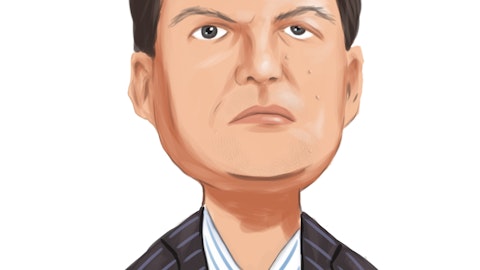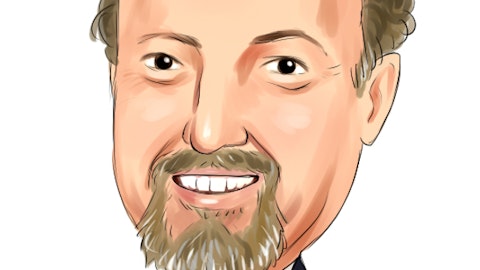Kenneth Vecchione: So running from Q3 to Q4, expenses absent the deposit cost will be relatively flat. And as we enter into 2024, there will be marginal expense growth and that marginal expense growth will be predicated on continuing to invest in new products, new services, new business lines, continuing to build out our risk management framework. The hallmark of Western Alliance has been this continuous investment through all cycles to kind of grow the business for future quarters and years. And so as long as the risk return and the investment returns are there, we’ll continue to do that.
Steven Alexopoulos: Got it. So from an efficiency ratio perspective, are you thinking that we’ll have improvement through 2024 or that will keep about where you end in the fourth quarter?
Kenneth Vecchione: Yes, I’d say about where we landed in the fourth quarter. Back to your first question, as we probably exit the second quarter and we achieve our loan-to-deposit ratio, we’ll be able to step on the accelerator of loan growth, and that will generate higher interest income, which should provide the denominator of that equation to grow at a faster pace. But right now, if you’re modeling, I would say, keep it consistent with Q4.
Steven Alexopoulos: Right. But it sounds like revenue is set to accelerate here with the margin being more stable, like you said, more loan growth coming in next year, but we should think you’re going to spend more of that, at least at this juncture, right? Because it seems like the setup is efficiency ratio improvement next year, where you’re saying at least at this point, don’t expect that.
Dale Gibbons: Look, I think it is set up that way, but it’s a little bit deferred in terms of when that takes place because of the reasons Ken is talking about that we’re going to be sluggish on having the loan growth really kind of match 85% of the deposit growth as we continue to pull that number to the LDR number down for a couple of more quarters.
Steven Alexopoulos: Got it. Okay. Thanks for taking my questions.
Dale Gibbons: Thanks, Steve.
Operator: Our next question comes from Chris McGratty of KBW. Chris, your line is open. Please go ahead.
Chris McGratty: Great. Thanks. Dale and Ken, I want to go about that one a little bit different. The — you’re already at your — you’re going to be at your 11% target within a couple of quarters, if not one to two quarters. What do you — I can’t — I’m not sure I’m prepared to ask this, but like wouldn’t you be thinking about a share buyback at some point next year given the capital accumulation in your stock price?
Kenneth Vecchione: Yes, I think that’s a fair question to ask. I think there are a couple of things that will inform our decision. One, as we continue to grow and we continue to get closer and closer to the $100 billion threshold, we have to take into account the AOCI charge that will be applied against it. And so we want to continue to grow our CET1 ratio. Really 11% is the target. It’s not the goal. And we expect to grow through that, all right? That’s one. And number two, you’ll see the CET1 ratio moderate in the back half of the year in terms of growth because we’ll probably step on the accelerator for loan growth once we achieve our loan-to-deposit ratio.
Dale Gibbons: And one of the reasons our ratio is planned so quickly is because we have really curtailed our risk-weighted asset increases, and that will pick up again as loan growth reaccelerates. I mean, we — I just — where the numbers saying, we’ve improved our CET1 ratio 190 basis points since we went on this risk-weighted assets dive and really paid a lot more attention to that, and we slowed our loan growth. And with our organic earnings, we’re able to move that number rather quickly from a year ago, which was 8.7% to where we are now at 10.6%.
Chris McGratty: Okay. That makes sense. It feels like there’s a combination of maybe both that could be considered in the back half of the year as the AOCI mark narrows and you get through your targets. It feels like a little bit of both.
Dale Gibbons: Yes.
Steven Alexopoulos: That’s fair. And then maybe a bigger picture question — keep going. Sorry.
Dale Gibbons: I was going to say, even if we’re higher for longer on rates, we will see that AOCI mark decline simply because the duration of the portfolio under five years, is going to continue to come down.
Kenneth Vecchione: Chris, just on that, I’d say to you and the rest of the folks on the line, we’re looking to build a very strong foundational balance sheet here, right, and not be sucked into any of the problems that you saw in the first quarter with the number of banks having their duration mismatched. And we just want to never go through that again. Or if we have to, have a minimal effect on us. And that’s where our intent is, to continue to raise capital levels and also to build our liquidity.
Chris McGratty: Great. And maybe just one follow-up. I think you’ve talked about a mid-teens ROE through the cycle. I guess, updated thoughts on that given the higher for longer?
Dale Gibbons: Well, I think there’s — so as our loan-to-deposit ratio continues to show kind of look — kind of where we’re headed, we are going to have more high-quality liquid assets. I think we can — over time, our expense ratio can fall into the 40s on an adjusted basis. And so I think high teens works for us kind of intermediate to longer term.
Chris McGratty: Okay. Thanks.
Operator: Our next question comes from Bernard von-Gizycki of Deutsche Bank. Bernard, your line is open. Please go ahead.
Bernard von-Gizycki: So just on deposit costs, maybe I can ask it a little differently. But when you think of how your ECR-related deposit grow based on your guidance, expectations could go for 2024. If rates are steady from here throughout 2024 versus if we do see rate cuts in the second half of 2024, how would you think the deposit costs could migrate under those two different way paths?





